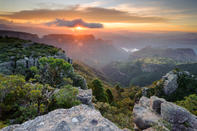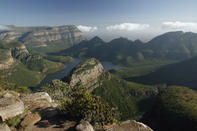Kruger to Canyons
One of the most exciting developments on the western boundary of the Kruger National Park is the Kruger to Canyons Biosphere Reserve, launched in 2001.

This is a community-based initiative that seeks to create a large conservation area that will eventually link the Kruger Park with the Eastern Transvaal Drakensberg escarpment in a ‘unique constellation of public, provincial, private reserves and natural resource areas’. The biosphere would also include the breathtaking Blyde River Canyon – said to be the third largest in the world. It is an ambitious project.
Over 1.5 million people live within the proposed biosphere, and the land belongs to dozens of different management authorities. Land usage currently includes agriculture, forestry, mining, rural developments, urban developments, tourism and conservation. Out of a total of 2.5 million hectares, 1.4 million is already dedicated to long-term conservation (900 000 ha of formally protected areas and 400 000 ha of privately owned conservation land).
Mouth-Watering Potential
Whatever challenges may lie ahead, the organisers are committed to their vision and are focused on engaging with the local communities and international organisations to realise their goals. Through a combination of audacious vision and responsible tourism, they hope to create an enormous biosphere reserve that embraces a truly remarkable bio-diversity.
The potential is mouth-watering. Animals have no respect for politics. They refuse to carry passports and simply cannot understand the invisible network of borders that dissect the land into nominal sovereign states. Instead, they prefer to move about as they please, following natural migration routes that were established many millennia before modern man stuck his oar in.
Natural Migration Routes

Conservationists have often noted this fact and it has been a long-standing goal of game preservation to transcend petty political boundaries. Now, this dream is coming true. Thanks in part to the revitalising effect of the tourism dollar on local economies, governments are getting together to declare large Transfrontier Conservation Areas (TFCAs) that extend, unbroken and unfenced, over several different countries.
These worthy endeavours are being driven by the Peace Parks Foundation, a non-profit organisation established in 1997. The three founding members of Peace Parks are the dearly beloved Nelson Mandela, the late tobacco baron Anton Rupert and the regal Prince Bernhard of the Netherlands, all of whom carry considerable cache. With that kind of backing, funds have been secured from several prominent institutions and Peace Parks has already made a real difference to the conservation landscape of southern Africa.
Transfrontier Conservation Areas (TFCAs)
Their activities are numerous: funding research programmes, supporting educational initiatives, building facilities, spearheading fundraising campaigns and generally promoting a holistic approach to conservation practises and management. But their main aim is to help establish Transfrontier Conservation Areas (TFCAs) that vault over the old colonial borders of Africa.
The SADC Protocol on Wildlife Conservation and Law Enforcement of 1999 defines a TFCA as “the area or component of a large ecological region that straddles the boundaries of two or more countries, encompassing one or more protected areas as well as multiple resource use areas”.
By David Fleminger During the 1890s, things grew chaotic in the Republic of the Transvaal (present day Mpumalanga). Since the discovery of gold, Johannesburg h...
During the 1890s, things grew chaotic in the Republic of the Transvaal (present day Mpumalanga). Since the discovery of gold, Johannesburg h...